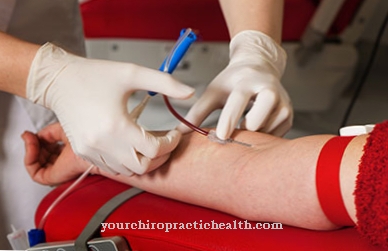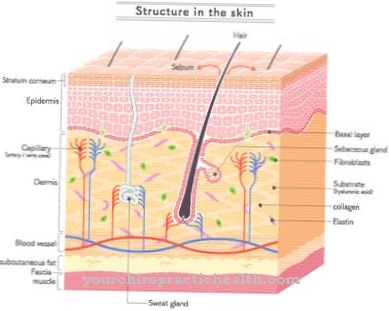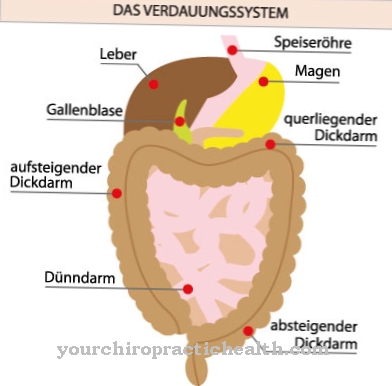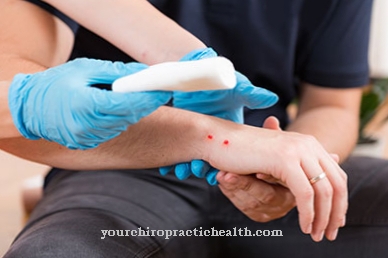As Bladder stones is the name given to urinary stones, which can usually develop in the urinary bladder, ureter or kidney. Typical signs are often urination disorders, blood in the urine or painful urination. Bladder stones should always be examined and treated by a specialist.
What are bladder stones?

Bladder stones are formed from salts that crystallize less often in the bladder than in the renal pelvis. Most of the bladder stones are made of calcium phosphate, calcium oxalate, or uric acid. These are substances that arise from water-insoluble compounds.
Bladder stones are of different sizes. In some cases, the bladder stones are very small and are called kidney gravel. Then there are bladder stones that fill the entire renal pelvis. Women are less prone to bladder stones than men.
If the bladder stones migrate from the kidney to the ureter, those affected can become trapped. Spasmodic or sharp pain (renal colic) suddenly occurs in the bladder and lumbar region. Some of those affected also complain of a strong urge to urinate, vomiting, chills or blood in the urine during colic. The bladder stones are very often rinsed out.
If the bladder stones are too large and cannot move, chronic pelvic kidney stones develop. Renal pelvic stones very often cause minor discomfort. It is only through the constant irritation of the kidney mucosa that it can lead to chronic pelvic inflammation in those affected. Chronic pelvic inflammation over the long term is the reason for a shrink kidney.
causes
Common causes of bladder stones are disorders of uric acid metabolism, calcium metabolism and other diseases that hinder the flow of urine and lead to urine concentration. Insufficient fluid intake, stress, psychological stress and a salty diet are further risk factors.
- Insufficient fluid intake
- Chronic urinary tract infections
- Uric acid metabolism disorders (including gout)
- Disorders in calcium metabolism
- Other conditions that impede the flow of urine and cause the urine to concentrate
Symptoms, ailments & signs
Bladder stones do not necessarily have to cause discomfort, it depends on the location and size. In some people they do not cause discomfort. If there is a stone in the bladder, it can usually come off the urethra without any problems.
It becomes difficult if the lower bladder outlet to the urethra is blocked. If a large stone is stuck there, the urine can build up and only a small amount of water may be left. In spite of urinating, the patients then continue to feel the need to urinate and have to go to the toilet accordingly.
Bladder stones are characterized by severe, colicky pain in the lower abdomen. The reason for this lies in the irritation of the mucous membrane by sharp-edged bladder stones. Urination itself can also be very painful because the urine cannot drain properly. Urinary congestion can reach the kidneys. If the urine is completely blocked, doctors speak of urinary retention (ischuria).
Many patients with bladder stones are internally restless because of the severe pain and are looking for a pain-free position. The pain attacks can be so severe that they cause nausea and vomiting. Sufferers should consult a doctor if they suspect bladder stones, because urine congestion up to the kidneys can lead to kidney damage.
course
If the bladder stones migrate from the kidney to the ureter, they can become trapped at constrictions in the urinary system. Spasmodic or sharp pain (renal colic) suddenly occurs in the bladder and lumbar region. Some of those affected also complain of a strong urge to urinate, vomiting, chills or blood in the urine during colic. The bladder stones are very often rinsed out.
If the bladder stones are too large and cannot move, chronic pelvic kidney stones develop. As the disease progresses, pelvic kidney stones cause minor discomfort. Chronic pelvic inflammation can only result from the constant irritation of the kidney mucous membrane. Chronic pelvic inflammation over the long term is the reason for a shrink kidney.
Bladder stones can block the drainage of the kidney and urine congestion occurs. The kidneys no longer work and the waste products to be eliminated collect in the blood instead. The various substances in the blood increase the levels and is known as urine poisoning (uremia).
Complications
Bladder stones usually do not cause any consequential damage. A sharp-edged stone is able to injure the urethra. The subsequent scarring can lead to chronic urination discomfort.
If urinary stones leave the kidneys via the urinary tract, there is a risk of them becoming stuck in the ureters, at the exit of the bladder, or in the urethra. This causes stabbing, cramp-like pain (colic) in the lumbar region, which often radiates into the lower abdomen and the unaffected side of the body. Severe, acute colic is always a medical emergency and requires immediate medical attention.
If bladder stones are stuck in one of the ureters, the outflow of urine is blocked. The urine congestion widens the renal pelvis and can become inflamed. Symptoms of severe, acute inflammation of the renal pelvis include fever and chills. In rare cases, blood poisoning (sepsis) is a life-threatening complication.
If bladder stones are stuck in one of the ureters, the outflow of urine is blocked. The urine congestion widens the renal pelvis and can become inflamed. Symptoms of severe, acute inflammation of the renal pelvis include fever and chills. If bladder stones are surgically removed, there are additional surgical risks.
When should you go to the doctor?
Problems with urination always require immediate and comprehensive medical clarification. If you have a specific suspicion of bladder stones, you should see your family doctor immediately. Symptoms such as frequent urination, unusually small amounts of urine or pain and cramps when urinating should be clarified immediately. In particular, the so-called staccato movement, in which the urine stream repeatedly breaks off while urinating, requires medical clarification.
A visit to the hospital is recommended if blood is found in the urine or if you experience bladder spasms with severe, labor-like pain. The symptoms mentioned do not go away by themselves, but even increase over the course of the disease. A doctor must be consulted at the latest when severe pain and an increasing feeling of illness are noticed.
Patients with osteoporosis, thyroid disease or existing urinary tract infections belong to the risk groups and should immediately discuss any complaints with their family doctor in order to avoid further complications. Other contacts are the urologist or the gynecologist.
Doctors & therapists in your area
Treatment & Therapy
It is advisable to have bladder stones treated only by a doctor. The doctor can use various tests to determine the size of the bladder stones and the location of the bladder stones. Those affected are usually prescribed a combination therapy consisting of anticonvulsant, pain reliever and flushing medication, increased fluid intake, warmth and plenty of exercise.
Sometimes the bladder stones can be dissolved with medication. When the bladder stones are conveniently located, they are removed with the medical snare. Doctors use shock wave treatment (ultrasound) to smash larger bladder stones. In some cases, surgery to remove the bladder stones is unavoidable. Then the removed bladder stones are analyzed in the laboratory for their composition and the salts from which the bladder stones were formed are determined.
The following home remedies have proven themselves as an alternative form of therapy for removing bladder stones:
- Salt-free, vegetarian diet (spicy dishes and meat-rich foods produce sharp urine! Bladder irritation occurs.)
- No cold drinks
- No coffee or alcoholic beverages
- The ingestion of plant-based drops (e.g. birch leaves, grouse, horsetail) promote the flushing of the urinary tract.
To reduce inflammation and to relieve pain, those affected can place hot linseed and hay flower packs in the bladder-lumbar area.
The person affected can fight inflammation foci with massages three to four times a day in the bladder and lumbar area. The person affected can use natural massage oil or a few drops of tea tree oil.
Apple cider vinegar has anti-inflammatory and antibacterial properties in the kidney and bladder area. The acid-base ratio is regulated in the urine. Apple cider vinegar stimulates the metabolism and promotes the removal of toxins and waste products through the skin. The kidneys are relieved and the performance of the kidneys is increased.
So that the bladder stones cannot deposit, those affected should drink a lot. Those affected who have already had bladder stones should avoid substances harmful to them in their diet. In general, when diagnosing bladder stones, the consumption of offal should be avoided. Urinary tract infections and bladder stones must always be treated by a doctor.
Outlook & forecast
In most cases, bladder stones are excreted in the urine and do not cause permanent damage to the urinary tract, although they can cause severe discomfort as they pass through the urethra. Sharp-edged bladder stones can injure the urethra or bladder wall, and the resulting scars can permanently impair urination.
Surgical removal of bladder stones is usually not necessary and it cannot guarantee that no new formation will occur afterwards. Bladder stones tend to form over and over again, especially in people who have had them before.
However, the outlook can improve if patients are careful in their lifestyle to minimize risk by eating a balanced diet and getting enough exercise. A diet rich in fiber and low in animal proteins is beneficial.
People with a tendency to stone formation should limit foods containing puric and oxalic acids, such as: B. Meat, especially offal, fish, seafood, spinach, Swiss chard, legumes, coffee and black tea, rhubarb. In addition, it is important to flush the urinary tract with plenty of drinking so that the sedimentation of mineral salts does not promote stone formation. But even these preventive measures cannot generally rule out the risk of stone formation.
Aftercare
Follow-up care is particularly important for urinary tract stones, including bladder stones. If no suitable follow-up measures are taken, stone formation occurs again in around 50 percent of cases, and multiple stone recurrences can also develop. One of the most important measures in aftercare is behavioral adaptation on the part of the patient.
These must take targeted action against the causes of urinary stone formation. These include, above all, bad eating habits, insufficient fluid intake, as well as being overweight and lacking exercise. Patients with a BMI of 25 or higher should definitely reduce their body weight first. If this is not possible on your own, a nutritionist should be consulted. Regular exercise also promotes weight loss.
Patients who do not do any sport at all or who exercise as little as possible due to their overweight often already show a half-hour walk a day or two to three hours of water aerobics a week. The reduction diet should also be combined with a change in diet and the regular consumption of large amounts of animal fat should be avoided. Regular consumption of fresh fruit and vegetables, on the other hand, has a positive effect on general well-being and promotes digestion.
In addition to changing their diet, many patients also need to increase their fluid intake. The amount of urine excreted regularly per day should be at least two liters.
You can do that yourself
For first aid with bladder stones, the urine should be diluted by drinking at least 2.5 liters of water or unsweetened tea so that excretion is forced and facilitated. To avoid cystine stones, the amount you drink should even be three liters. One liter of it is to be drunk at night.
A drink made from freshly poured couch grass with hot water helps to rinse out the bladder stones better. Two cups of corn, rosemary or fennel tea a day help with dehydration. The tried and tested home remedies also include a cure with elderberry juice. 50 ml should be drunk daily.
Basically, the food should be low in calcium, as this also means that little oxalate is absorbed. For this reason, foods that should not be eaten consistently include rhubarb, beets, Swiss chard and spinach as well as nuts, cola, black tea and coffee. Foods that are low in oxalates include cherries, apricots, and pears. Salad, as well as raspberries and apples, can be incorporated into the menu in moderation. Rice is also recommended as it has a strong dehydrating effect.



























